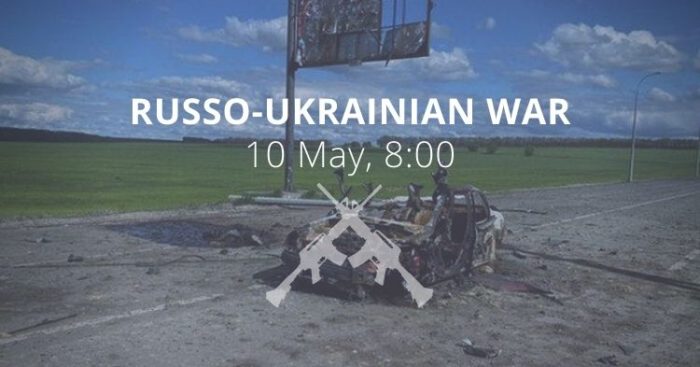Morning report day 64 – April 28
Situation
According to information from the General Staff:
Russian forces continue to carry out offensive operations in the Eastern Operational Zone in order to defeat the Joint Forces, establish full control over the territory of Donetsk and Luhansk oblasts and maintain the land route with the occupied Crimea.
 Russian forces increase the pace of the offensive operation. In almost all directions, the Russian occupiers are exerting intense fire. The greatest activity is observed in Slobozhansky and Donetsk directions.
Russian forces increase the pace of the offensive operation. In almost all directions, the Russian occupiers are exerting intense fire. The greatest activity is observed in Slobozhansky and Donetsk directions.
No significant changes in the activities of Russian forces units were noted in the Volyn and Polissya areas.
- By maintaining an appropriate set of troops, Russian forces are trying to ensure the maintenance of the reserves of the Armed Forces of Ukraine in the northern direction and prevent their movement to the Eastern Operational Zone.
In the Slobozhansky direction, the Russian forces continue to strike and fire artillery at the city of Kharkiv.
- The main efforts of Russian occupiers are focused on the Izium direction. Russian forces are trying to launch an offensive in the directions of Sulyhivka – Nova Dmytrivka and Andriivka – Velyka Komyshuvakha.
- To strengthen the advancing group, Russian occupiers moved additional airborne units to the city of Izium, as well as up to 500 units of technic.
- Russian forces carried out systematic artillery shelling, including multiple rocket launchers, in the cities of Kharkiv and Dergachi and the settlement of Prudyanka.
- In the direction of Izium – Barvinkove, Russian occupiers attempted an offensive in the area of Nova Dmytrivka. They were unsuccessful, lost and left.
In the Donetsk direction, the Russian forces continue to take active action on the line of contact. The main efforts are focused on surrounding the Defense Forces of Ukraine.
- In the Donetsk and Tavriya directions, Russian forces continue to shell the positions of our troops along the line of contact with mortars and artillery.
- To achieve this goal, in the Lyman direction, Russian forces have improved their tactical position, trying to develop an offensive on the village of Lyman. Russian invaders are carrying out preparatory measures for forcing the Siversky Donets River.
- In the Sievierodonetsk direction, Russian forces are attacking the settlement of Orikhove.
- In the direction of Avdiivka, in order to capture Marinka and Ocheretyn, Russian forces exert intense fire.
- In the Kurakhiv direction, with the support of artillery, Russian occupiers are conducting an offensive in the directions of Staromayorske – Velyka Novosilka and Lyubimivka – Zelene Pole.
- Russian forces made an unsuccessful attempt to break through the defenses of Ukrainian troops in the Kurakhovo area.
- Russian occupiers continue to suffer losses on land. In the Donetsk and Luhansk oblasts only, six attacks have been repulsed in the past 24 hours, five tanks, one artillery system, twenty-two armored vehicles, one car and one anti-aircraft gun have been destroyed.
In the Tavriya direction, Russian forces units continue to conduct demonstrations and manoeuvres to mislead and prevent the transfer of Ukrainian troops to other areas.
Russian occupiers continue to use Melitopol airfield as the base and flight of Su-25 attack aircraft, Ka-52 attack helicopters and Mi-8 transport and combat aircraft.
In the Pivdennyi Buh direction, Russian forces focus on the Kherson-Mykolayiv and Kherson-Kryvyi Rih directions.
- As a result of the assault, Russian forces established themselves in the area of the settlement of Tavriyske, trying to carry out a fire defeat on the positions of Ukrainian troops in the areas of the settlements of Oleksandrivka and Nova Zorya. In the areas of settlements Stanislav and Molodetske, there are increases in the Russian units of rocket and barrel artillery.
- In order to correct and assess the results of the fire damage, Russian forces conducted air reconnaissance in the area of the settlement of Zatoka.
- Russian forces, under cover of artillery fire, continue to improve the engineering equipment of the positions, replenish stocks of material and technical means, ammunition, and fuel, and conduct air reconnaissance. Russian occupiers tried to improve the tactical position of their troops in the direction of Zaporizhzhia. They have no success, they left with losses.
Russian cruise missile attacked Zaporizhia. It was launched from a plane. Two private houses were destroyed. There are at least 3 victims (to be updated) – Oblast Administration https://t.co/CNLOjPtzlf pic.twitter.com/PEOoLXrUOT
— Euromaidan Press (@EuromaidanPress) April 28, 2022
- In the Transnistrian region of the Republic of Moldova, due to numerous provocations from Russia, the terrorist threat level “red” has been introduced. The personnel of the security forces was transferred to the “barracks state”, the control at the checkpoints was strengthened, and the preparations for the May 9 holiday parade were canceled.
During the previous day, eight air targets were hit by units of the anti-aircraft missile forces of the Air Force and the Land Forces: one plane, one cruise missile, and six UAVs of operational and tactical level.
In the temporarily occupied territory of Kharkiv oblast, near the village of Levkivka, Izium district, Russian forces organized a collection point for damaged equipment, where military equipment is being repaired and restored. Russian invaders continue to carry out so-called “filtration measures” in some settlements temporarily out of control of the Ukrainian authorities.
In the temporarily occupied territory of the Zaporizhzhia oblast, Russian occupiers are inspecting the houses of local residents to identify the places of residence of representatives of the security forces of Ukraine. Carrying out a census of the local population, movement in the temporarily occupied territory without identity documents is prohibited.
In the temporarily occupied territory of the Kherson oblast, Russian occupiers are preparing for a so-called “referendum”, bulletins are being printed, and personal data of local citizens of Ukraine are being clarified. At the same time, Russian invaders continue to prevent civilians from leaving the occupied territory.
Russian forces are demoralized. Personnel who are taken to replenish losses from the occupied territories of Donetsk and Luhansk oblasts have their documents confiscated, which will not allow them to be identified in the event of death. There have been more and more cases of forces soldiers searching for new ways to avoid participating in hostilities. Personnel resort to desertion, captivity and self-mutilation.”
Mysterious Explosions Throughout Russia, Belgorod Ammunition Depot on Fire, the Newsweek reported yesterday.
- A fire broke out in an ammunition depot on Wednesday in the village of Staraya Nelidovka, some 20 miles from the Ukrainian border, Belgorod’s regional governor Vyacheslav Gladkov wrote on Telegram. He heard several blasts.
- Similar blasts could be heard at the same time in the city of Belgorod, which is close to the Ukrainian border, some 205 miles away from Bryansk, the city where an oil depot was reported on fire on Monday, April 25.
- A Voronezh district civil defense and emergency official said that two loud bangs were heard in the Shilovo neighborhood Tuesday night, according to TASS. The area is strategically positioned near a military airfield and is approximately 180 miles away from the Ukrainian border.” (According to Russian media, Russian Air Defense shot down two Ukrainian UAVs – HPM).
- According to RBC, two further explosions were heard around midnight tonight. Two hours later, another explosion was heard in the south of Belgorod on Thursday 28 April. TASS reported that the air defense worked.
Mystery fires at sensitive facilities compound Russia’s war challenge, the Washington Post reports, highlighting further potentially linked incidents in Russia.
- Last Thursday, a blaze tore through the upper stories of the Defense Ministry’s Second Central Research Institute in the town of Tver, northwest of Moscow. The institute is known as a center for highly sensitive research on key missile systems, including Russia’s most advanced stealth programs, as well as the Iskander missile, extensively used in Ukraine, and the S-400 air defense system.
- Hours later, Russia’s biggest chemical plant burned down, also for unknown reasons. The Dmitrievsky Chemical Plant, located about 208 miles northeast of Moscow in Kineshma, was a major supplier of propellants essential for the production of the precision-guided missiles Russia needs for the war.
- A third fire then engulfed a sensitive facility at the College of Aerospace Engineering and Technology in the Moscow suburb of Korolyov, which is renowned as the home of the Soviet Union’s and Russia’s space programs.
The explosions in 3 regions of Russia: “Divine intervention”, the Ukrainska Pravda reports. Adviser to the head of the President’s Office Mykhailo Podoliak called the explosions in the Belgorod, Voronezh, and Kursk oblasts of Russia a “completely natural process” and a “divine intervention in the affairs of sinners.”
Russia is preparing a missile strike on Transnistria with civilian casualties, the Defense Intelligence of Ukraine (DIU) warns citing SBU. Residents of the unrecognized “Transnistrian Moldavian Republic” receive SMSs on behalf of the Armed Forces and special services of Ukraine. They contain a warning about a “missile and artillery” strike on the territory of the “Transnistrian region”.
Quote from the fake message: “Ukraine’s Security Service urges the evacuation of civilians to safer regions. We assure you that the Armed Forces of Ukraine do not wish harm to civilians, but the people who remained in the cities will be perceived as sabotage groups and will be eliminated without warning. Exactly at 19.00 rocket and artillery shelling of objects on the territory of the republic will be carried out “.
These reports are actively covered by Russian propaganda information resources. We note that the state of Ukraine has nothing to do with this and similar provocations. Such fakes and incidents, which are likely to take place on the territory of Transnistria, are nothing more than another provocation of the Russian special services against Ukraine and Moldova.”
According to British Defense Intelligence, (last 24 hours):
- Approximately 20 Russian Navy vessels are currently in the Black Sea operational zone, including submarines.
- The Bosporus Strait remains closed to all non-Turkish warships, rendering Russia unable to replace its lost cruiser Moskva in the Black Sea.
- Despite the embarrassing losses of the landing ship Saratov and cruiser Moskva, Russia’s Black Sea Fleet retains the ability to strike Ukrainian and coastal targets.
As of Thursday 28.04.2022, the approximate losses of weapons and military equipment of the Russian Armed Forces from the beginning of the war to the present day:
- Personnel – more than 22800 people (+400),
- Tanks – 970 units (+31),
- Armored combat vehicles – 2389 units (+47),
- Artillery systems – 431 (+10),
- Multiple rocket launchers – 151 (+2)
- Air defense means – 72 (+1),
- Aircraft – 187 (+2),
- Helicopters – 155 (+0),
- Automotive technology – 1688 (+22),
- Vessels/boats – 8 units (+0),
- Fuel and lubricant tanks – 76 (+0),
- UAV operational and tactical level – 215 (+8)
- Special equipment – 31 (+0)
- Mobile SRBM system – 4 (+0)
Humanitarian
According to UNHCR 5,317,219 refugees have been registered as of April 26. The UN says that so far Poland has taken in 2,944,164 refugees, Romania 793,420, Russian Federation 627,512, Hungary 502,142, Republic of Moldova 437,362 Slovakia 360,458, and Belarus 24,719. Among those who fled Ukraine are also Ukrainian nationals with dual citizenship. An additional 105,000 people moved to the Russian Federation from the Donetsk and Luhansk oblasts between 18 and 23 February.
The UN Secretary General Antonio Guterres visited devastated Borodianka near Kyiv. He arrived in Ukraine after he met with Putin. https://t.co/vf934W5W5k
— Euromaidan Press (@EuromaidanPress) April 28, 2022
The number of Ukrainians entering Ukraine since February 28 – is 1,209,500 as of April 25. This figure reflects cross-border movements, which can be pendular, and does not necessarily indicate sustainable returns.
OHCHR recorded 5,939 civilian casualties in Ukraine as of April 26. 2,787 were killed (including 202 children) and 3,152 injured (including 302 children).
The Marines ask to be “extracted” from Mariupol, Ukrainska Pravda reports.
“For 62 days we have been fighting in the full encirclement, now we are territorially at the Azovstal plant, we perform tasks together with units of the Azov Regiment and other units that are surrounded… In our group there are more than 600 wounded guys of varying severity, they are in dire need of medical care, there are no conditions, no drugs, and no staff who could help them. There are also civilians wounded, whom we help as much as we can. Hundreds of civilians, dozens of children, many people with disabilities and the elderly are with us. The situation is difficult, there are problems with water. “
Russian troops destroyed a military hospital in Azovstal in Mariupol after a night of heavy bombing. Among the already wounded servicemen are dead and newly wounded. The operating room was also destroyed, which made impossible any help even in poor conditions—the Azov regiment pic.twitter.com/dcGrd9ee8K
— Euromaidan Press (@EuromaidanPress) April 28, 2022
Environmental
Europe’s economy would be hit by a wider cutoff of Russian gas, The New York Times reports. The euro slumped to a five-year low on worries about energy security and a slowdown in European growth.
Russia’s war on Ukraine is already rippling through Europe, lashing energy prices and hurting manufacturers just as the bloc was recovering from a pandemic-induced recession. The International Monetary Fund last week cut its 2022 forecast for the countries that use the euro to 2.8 percent, from a 3.9 percent estimate in January, with Germany, the largest economy, taking a big hit. … But the specter of an outright energy war — including a potential European embargo on Russian gas and oil — is looming at a vulnerable time. European companies are already facing higher energy costs, which are threatening profit margins and squeezing consumers’ purchasing power, analysts said. The European Union has been drafting plans for an embargo on Russian oil but made no mention of it in the hours after Gazprom’s cutoff. Europe put in place a ban on Russian coal this month. And while Germany in particular has resisted embargoes on Russian oil or gas because of the outsize costs to its industry, officials have recently reconsidered. “This is a thinly veiled threat to Germany— Berlin is currently weighing how far it and the E.U. can go in sanctioning Russian energy exports, and the Russian threats are directed to change its calculus,” said Jonathan Hackenbroich, a policy fellow at the European Council on Foreign Relations. Still, a full gas cutoff for Germany “would have dire consequences for the German and European economies,” he added. “Factories would have to curb production or even close. Some key industries could be lost forever, and it is in fact hard to assess the full range of consequences. But Russia is also highly dependent on revenue from energy exports as they represent its last big lifeline,” Mr. Hackenbroich said. An embargo on Russian energy is likely to trigger a European recession, and high inflation “would become even higher inflation,” said Carsten Brzeski, global head of research at ING Bank. “All of this is clearly negative for the short-term outlook,” he said. “But to make it worse, high energy and commodity prices and disrupted supply chains will all put Europe’s international competitiveness at risk.”
Legal
The US says it has information Russia executed Ukrainians trying to surrender, the Washington Post reports.
“The United States has credible information that a Russian military unit executed Ukrainian forces trying to surrender in Donetsk, said Beth Van Schaack, the US ambassador at large for global criminal justice. If these suspicions are true, she said, it would be a violation of a fundamental principle of the laws of war: “The prohibition against the summary execution of civilians and of combatants who are hors de combat by virtue of surrender, injury, or other forms of incapacitation,” Van Schaack said, speaking at a UN meeting Wednesday discussing alleged Russian atrocities in Ukraine.”
In May, the Russians are preparing “referendums” on the annexation of Donbas, the Meduza reports. “As Moscow’s full-scale invasion of Ukraine enters its third month, the Russian Défense Ministry has officially declared that its main aim has shifted to taking “full control” of the Donbas and southern Ukraine. Establishing “full control” will involve orchestrating pseudo-referendums on the self-proclaimed Donetsk and Luhansk “People’s Republics” joining the Russian Federation — and on Russian-occupied Kherson declaring independence from Ukraine.
However, these “referendums” have already been postponed until May, allegedly due to Russia’s military failures in Ukraine. According to three Meduza sources close to Putin’s administration, the self-declared Donetsk and Luhansk “People’s Republics” (the DNR and LNR) may be set to hold Kremlin-engineered referendums on joining the Russian Federation in mid-May. Two of these people even gave specific dates for the planned “votes” — May 14 and 15, 2022.
Men are being abducted a masse in the occupied territories, DIU claims. Large-scale “filtration measures” are being carried out in the forces-occupied territories of Kharkiv, Zaporizhzhia, Kherson, Mykolaiv, Luhansk and Donetsk oblasts. The victims of the occupiers are often men of military age. First of all veterans, former military, law enforcement officers, and pro-Ukrainian activists.
More than 300 pro-Ukrainian activists and veterans are being interrogated and tortured on the premises of the Kherson pre-trial detention center. A filtration camp has been set up in the village of Velyka Lepetykha in the Kherson Oblast. Recently, about 400 Russian servicemen dressed in Rosguard uniforms arrived at the camp to search for and detain men of military age.
The detained Ukrainian men are being taken in the direction of the occupied Crimea. The main purpose of such actions is to “replenish the exchange fund”. Ukrainian hostages are planned to be exchanged for Russian war criminals. Even if Ukrainians did not take part in the 2022 hostilities.
It is also possible to organize propaganda “victory parades” with the participation of detained Ukrainians. According to the information received, they may be presented as “prisoners of war” and marched through the streets of occupied cities. Similar events took place in Donetsk in 2014. Then, after numerous tortures, Ukrainian heroes were forced to walk through the central street of Donetsk, where they were subjected to bullying and humiliation. These actions of the Russian authorities are another war crime.
More than a million people have been “evacuated” to Russian territory from dangerous regions of Ukraine since the start of the “special military operation”, RIA Novosti claims.
“Despite the obstacles created by Kyiv, over the past day, without the participation of the Ukrainian authorities, 16,480 people were evacuated to the territory of the Russian Federation from dangerous regions of Ukraine, Donetsk and Luhansk people’s republics, including 3,354 children, and since the start of the “special military operation” – there are already 1,002,429 people, of which 183,168 are children,” Colonel-General Mikhail Mizintsev, head of the Russian National Defense Control Center, said.
(Having started the war and conducted massive atrocities, including indiscriminate bombing, artillery attacks and missile strikes on residential areas, widespread war crimes on occupied territories, and established filtration camps, the narrative that Ukrainians are being “evacuated” to Russia comes across as a part of its perverted propaganda. – HPM).
The Ukrainian authorities have repeatedly reported on the forced deportation of Ukrainians, including orphans, to Russia, in particular from Mariupol and Izium, the Ukrainska Pravda reports. This violates international law. The Russian reported narrative indicates the scale of it.
 217 children were killed, and 393 children injured, the Office of the Prosecutor General of Ukraine reports as of 28 April. 1,508 educational establishments are damaged as a result of shelling and bombings, 102 of them are destroyed fully. 8,653 crimes of aggression and war crimes and 4,129 crimes against national security were registered.
217 children were killed, and 393 children injured, the Office of the Prosecutor General of Ukraine reports as of 28 April. 1,508 educational establishments are damaged as a result of shelling and bombings, 102 of them are destroyed fully. 8,653 crimes of aggression and war crimes and 4,129 crimes against national security were registered.
Support
In two months, the Return Alive Foundation bought equipment for the army for almost 2 billion hryvnias, the Ukrainska Pravda reports. “Taras Chmut, director of the Return Alive Foundation, said that in two months of a full-scale Russian invasion of Ukraine, volunteers had bought the necessary equipment for the army for 2 billion hryvnias. With these funds, we managed to buy 126 UAVs, almost 3,000 quadcopters, 17,000 bulletproof vests, more than 4,000 thermal imagers, night and other optics, etc.”
As Raytheon struggles to replenish Stinger missiles, lawmaker pushes Defense Production Act, Defense News reports. The US may not be able to make more of the shoulder-fired Stinger anti-aircraft missiles it has been sending to Ukraine until at least 2023 due to parts and materials shortages, the head of manufacturer Raytheon Technologies said Tuesday. The revelation, during Raytheon’s quarterly earnings call, underscores the challenge facing the Pentagon and defense industry as they seek to boost arms production in response to the ongoing Russia-Ukraine conflict. The bottleneck is fueling recommendations from Capitol Hill that President Joe Biden invokes the Defense Production Act to prioritize supplies of components for weapons like the Stinger.
Partisan politics threaten to derail Ukraine’s aid package as Biden runs out of money, Defense News reports. President Joe Biden has nearly run out of funds to continue sending highly sought-after US military aid to Ukraine, and partisanship in Congress threatens to hold up swift passage of a bill for additional assistance. An official from the White House’s Office of Management and Budget told Defense News that Biden only has approximately $250 million left out of the $3.5 billion that Congress authorized for the president to use in transferring military equipment to Ukraine from the US stockpiles.
Norway to allocate $44 mln to British-led Ukraine weapons procurement, the Reuters reports. Norway will allocate 400 million crowns ($43.7 million) to a British-led initiative for buying weapons for Ukraine, the Norwegian prime minister said on Tuesday. Norway may also make additional direct shipments of weapons to Ukraine on top of those it has already made, Jonas Gahr Stoere told parliament.
Australia to send Ukraine howitzers and ammo, the Ukrinform reports. Australia will give Ukraine more heavy artillery weapons and ammunition. That’s according to Australian Associated Press, Ukrinform reports. The $26.7 million package of military assistance will see Ukraine provided with six M777 lightweight towed howitzers along with ammunition. It takes Australia’s military assistance contribution to Ukraine to $225 million, with a further $65 million provided in humanitarian aid along with more than 70,000 tonnes of thermal coal.
The EU is discussing the seizure of Russian assets in favor of Ukraine, the Economic Truth reports. The European Union is discussing how to seize Russian assets to direct these funds in favour of Ukraine. Poland calls on allies to agree on an appropriate mechanism at the EU level. This was stated by Deputy Foreign Minister of Poland Pavel Jablonski to the Financial Times. Warsaw says the property of Russian oligarchs affected by the sanctions, as well as the hundreds of billions of euros in reserves of Russia’s central bank frozen by Western powers, must be available for the cost of rebuilding Ukraine. “We believe that a political decision must be made, that we want to go in this direction, and that we are ready to confiscate these assets forever. How to do it – is open to discussion,” he said.
New developments
- Putin is threatening “lightning strikes” on those who want to intervene in the war, the Ukrainska Pravda reports. ” “If someone decides to intervene in current events in Ukraine from the outside and creates unacceptable strategic threats for Russia, then they must know that our response, our retaliatory strikes, will be lightning-fast, quick. We have all the tools for this – such that no one else can boast of right now. And we won’t brag – we’ll use them if needed! And everyone should know about it! All decisions in this regard have already been made.” The Russian president stated that all goals and objectives of the war would be “achieved.” He did not clarify exactly what was meant by this.
- Moldovan breakaway region claims shots were fired from Ukraine towards the village, the Reuters reports. “Moldova’s pro-Russian breakaway region of Transdniestria said on Wednesday that shots were fired from Ukraine towards a village that houses an ammunition depot, the latest report to raise concern that Russia’s war in Ukraine might expand.” ME: The “claim” must be seen in the context of yesterday’s statement from the Ministry of Foreign Affairs of Ukraine: “Ukraine strongly supports Moldova’s territorial integrity within its internationally recognized borders, condemns desperate attempts to drag Moldova’s Transnistrian region into a full-scale war against Ukraine on February 24, and calls for de-escalation of tensions.”
- EU brands Russian gas halt ‘blackmail’, working on a response, the Reuters reports. “The EU’s chief executive on Wednesday branded as “blackmail” Russian giant Gazprom’s move to halt supplies to some European customers, but said the bloc was working on a coordinated response to Moscow’s escalation.”
- Finnish, Swedish security services warn of Russian meddling over expected NATO bids, the Reuters reports. “Finland and Sweden must prepare for increased Russian spy operations, cyber-attacks and attempts to influence lawmakers as they consider joining NATO after Moscow’s invasion of Ukraine, the Nordic nations’ intelligence chiefs said on Wednesday.”
- The time and context of Zelenskyy’s meeting with Putin are not yet determined, the Ukrinform reports. That’s according to Mykhailo Podoliak, the adviser to the head of the President’s Office, who commented on the statement of the Turkish defense chief claiming such a meeting could take place in the coming days.
- Canadian MPs unanimously back the motion recognizing Russian ‘genocide’ in Ukraine, the Global News reports. The Canadian House of Commons on Wednesday unanimously backed a motion to recognize Russian President Vladimir Putin’s butchery and brutality during the invasion of Ukraine as genocide. The motion was adopted. By passing the motion, the House of Commons also recognized that “there is clear and ample evidence of systematic and massive war crimes and crimes against humanity being committed against the people of Ukraine by the Armed Forces of the Russian Federation, directed by President Vladimir Putin and others within the Russian Parliament.”
- PACE to support inquiries into Russian crimes, violations of international law, the Ukrinform reports. That’s according to a resolution and recommendation “Consequences of the Russian Federation’s continued aggression against Ukraine: role and response of the Council of Europe”. “PACE said it was “alarmed at the mounting evidence of atrocities committed by Russian armed forces” and expressed its full support for all efforts aimed at investigating violations by Russia of international human rights and international humanitarian law and other international crimes, including war crimes, crimes against humanity and genocide, and ensuring the accountability of the aggressor.”
Assessment
On the War
The Institute for the Study of War has made the following assessment as of Wednesday 27 April:
Russian forces continued ground and air assaults against Ukrainian defenders in Mariupol’s Azovstal Steel Plant on April 27. The Ukrainian military reported that Russian forces continued to conduct a high tempo of airstrikes against Ukrainian defenders, including by Tu-22M3 strategic bombers. Advisor to the Mayor of Mariupol Petro Andryushchenko and the commander of the Ukrainian 36th Marine Brigade separately reported that Russian forces continued ground assaults on the Azovstal facility and that Ukrainian forces are running low on food, water, and ammunition.
Russian forces made marginal advances in frontal assaults around Sievierodonetsk, Rubizhne, and Popasna on April 27 and continued to shell the entire frontline. The Ukrainian General Staff confirmed that Russian forces captured Novotoshkirske, a small town 25 km south of Sievierodonetsk, and attempted to advance further west. Russian forces advancing south from the Svatove area (west of Rubizhne) additionally captured the town of Zarichne. Ukrainian forces repelled Russian attacks in Avdiika, near Donetsk city. Russian forces are making slow progress on these multiple small axes of advance, likely due to their increasing use of concentrated artillery, but their ability to encircle Ukrainian forces and the extent to which they will be able to advance remain unclear.
Russian forces in Izium continued attacks on three lines of advance – southeast towards Sloviansk, southwest towards Barvinkove, and directly west away from Donetsk Oblast – on April 27. The Ukrainian General Staff reported that Ukrainian forces repelled Russian attacks near Nova Dmytrivka, towards Barvinkove, and repelled unspecified attacks towards Sloviansk.
Russian forces made territorial advances directly west of Izium, capturing the town of Zavody and the outskirts of Velyka Komyshuvakha, 20km west of Izium. Russian forces west of Izium most likely intended to pivot southwards and advance on Barvinvoke after completing the capture of Velyka Komyshuvakha, seeking to bypass Ukrainian defenses along the T2122 highway. These forces could alternatively attempt a deep encirclement of Ukrainian forces that is unlikely to succeed, as Russian forces pushing west of Izium are moving away from the otherwise mutually-supporting Russian lines of advance roughly converging west of Sievierodonetsk.
Key Takeaways
- Concentrated artillery is likely enabling limited Russian advances in eastern Ukraine, though Russian forces continue to struggle to break through prepared Ukrainian defenses.
- Russian forces funneled additional reinforcements and tactical missile units into the Izium front and made minor advances. Russian forces are likely attempting to bypass Ukrainian forces on the road to Barvinkove by advancing directly west before pivoting southwards in the coming days.
- Heavy Russian bombardment and continued assaults failed to make headway against Ukrainian defenders in Mariupol’s Azovstal plant, even as Russian forces reportedly prepared to stage a press tour in the occupied areas of the city on April 28.
- Russian forces around Kherson are likely preparing for a renewed push to capture the entirety of Kherson Oblast in the coming days but Ukrainian counterattacks continue to disrupt Russian operations in the area.
- Russian occupation forces continued preparations to announce the creation of a Russian proxy “Kherson People’s Republic” (KNR) amid widespread Ukrainian resistance.
- The Kremlin may be preparing to either bring Transnistria into the war in Ukraine or destabilize Moldova itself to put additional pressure on NATO.“
Fears Are Mounting That Ukraine War Will Spill Across Borders, The New York Times reports. For nine weeks, President Biden and the Western allies have emphasized the need to keep the war for Ukraine inside Ukraine.
In the past three days, the American secretary of defense has called for an effort to degrade the capability of the Russian military so that it could not invade another country for years to come. The Russians have cut off gas shipments to Poland and Bulgaria, which joined the North Atlantic Treaty Organization after the collapse of the Soviet Union; Ursula von der Leyen, the president of the European Commission, immediately denounced the move as an “instrument of blackmail.” Explosions have rocked a disputed area of Moldova, a natural next target for the Russians, and gas depots and even a missile factory in Russia have mysteriously caught fire or come under direct attack from Ukrainian forces. And with increasing frequency, the Russians are reminding the world of the size and power of their nuclear arsenal, an unsubtle warning that if President Vladimir V. Putin’s conventional forces face any more humiliating losses, he has other options. American and European officials say they see no evidence the Russians are mobilizing their battlefield nuclear forces, but behind the scenes, the officials are already gaming out how they might react to a Russian nuclear test, or demonstration explosion, over the Black Sea or on Ukrainian territory. … American and European officials say their fears are based in part on the growing conviction that the conflict could “go on for some time,” as Secretary of State Antony J. Blinken put it recently. Talk of a diplomatic resolution or even a cease-fire … has died out. Both Ukrainian and Russian forces are digging in for the long haul, focusing on what they expect will be an artillery war in the south and east of the country, where Russia has focused its forces after a humiliating retreat from Kyiv and other key cities. But so far, the war has stayed largely within the geographical confines of Ukraine. The United States and its allies said their goal was to get Russia to withdraw its forces “irreversibly,” as Mr. Blinken put it, and respect Ukraine’s borders as they existed before the invasion. Mr. Biden declined to impose an no-fly zone that would pit American and Russian pilots against each other. Mr. Putin denounced the influx of Western weapons to help the Ukrainian military, but has never attacked those supply lines inside NATO territory. Now, there are signs that the restraint is fracturing.”
Consequences and what to do?
PACE urges maximum pressure on Russia to cease its aggression and unity in supporting Ukraine. Describing Russia’s aggression against Ukraine as “an act of unprecedented gravity” with far-reaching consequences worldwide, PACE has made a strong call for unity in supporting Ukraine and maximum pressure on the Russian Federation to immediately and unconditionally cease its aggression, as well as “decisive action” by the international community to defend the democratic world order.
Approving a resolution and recommendation on the basis of a report by Frank Schwabe (Germany, SOC), the Assembly declared: “A new dividing line is back on the map of Europe, drawn by the Russian authorities with their rhetoric and deeds.”
Russia’s aggression had also, among other things, provoked the direst humanitarian crisis in Europe since the Second World War, posed a challenge to global governance, and led to a steep rise in energy costs and food insecurity, the parliamentarians pointed out.
“It is not only the magnitude of the current challenge but also the Council of Europe and its member States’ response to it which will shape the future of European history,” they said.
Ukraine fate hangs ‘in balance’, Liz Truss warns in call for west to boost military spending, the Independent reports. The fate of Ukraine remains “in the balance”, foreign secretary Liz Truss has warned as she called for allies to increase defense spending and supply tanks and warplanes to Kyiv.
“She will argue that Western allies should impose tougher economic sanctions, including cutting off oil and gas imports “once and for all”, adding: “There must be nowhere for Putin to go to fund this appalling war.”
Ms Truss will use her speech at London’s Mansion House on Wednesday to say: “We cannot be complacent – the fate of Ukraine remains in the balance.
“And let’s be clear – if Putin succeeds there will be untold further misery across Europe and terrible consequences across the globe. We would never feel safe again.”
Ms Truss will say: “We must be prepared for the long haul and double down on our support for Ukraine. Heavy weapons, tanks, airplanes – digging deep into our inventories, ramping up production. We need to do all of this.”
The UK was one of eight NATO members to meet the alliance’s goal of spending at least 2 percent of gross domestic product (GDP) on defense in 2021. Ms. Truss will argue that there has been a “generation of under-investment” in the west and the 2 percent target should be “a floor, not a ceiling”.
The foreign secretary is also expected to say that the Russian invasion shows “the architecture” of the international order has failed Ukraine. Russia’s position as a veto-wielding member of the UN Security Council has limited that body’s ability to censure the Putin regime. Ms. Truss will set out a new approach that recognizes “we’re seeing the return of geopolitics”.
Ms. Truss wants to see the G7, the UK, US, Canada, Japan, France, Germany, and Italy, playing a stronger role on the world stage. She also wants to forge a stronger network of bilateral security and economic partnerships. An ally of the cabinet minister said her speech is in recognition of the fact that the West has been “asleep at the wheel since the Cold War”.”
Putin has room to withdraw from Ukraine, the Reuters reports. British Prime Minister Boris Johnson said on Tuesday he did not expect any further Russian military failures in Ukraine to push President Vladimir Putin into using tactical nuclear weapons there, saying he had room to maneuver and end the conflict.
“Asked by Talk TV if he expected Putin to consider using tactical nuclear weapons if he suffered more military failures in Ukraine, he said: “No, I don’t.”
“Given the massive Russian backing for what he is doing, given the apparent obliviousness of the Russian media about what is really happening in Ukraine, the paradox is that Putin has far more political space to back down, to withdraw,” he said.”
Assessment by Hans Petter Midttun:
“Fears Are Mounting That Ukraine War Will Spill Across Borders” the headline in The New York Times reads. The article argues that while “the war has stayed largely within the geographical confines of Ukraine” there are now signs that the restraint is fracturing.
This is a much too common view and reflects the strategic messaging by Western leaders. It does, however, not stand up to scrutiny.
The European Parliament recommendation EU Parliament “Direction of EU-Russia political relations” as of 16 September 2021, states that freedom, stability, and peace on the European continent and beyond are being threatened by the aggressive policies of the Russian authorities. “Russian regime is threatening peace and security in Europe by continuing with systemic human rights violations against its people and aggressive behavior in its foreign policy, including but not limited to: large-scale military exercises and military build-ups; the illegal and violent occupation and annexation of Crimea; the violation of the territorial integrity and the destabilization of Ukraine, Georgia, and the Republic of Moldova; support for frozen conflicts and its failure to respect ceasefire agreements in Georgia and Ukraine; alleged acts of terrorism on the territory of the EU Member States such as Czechia; cyberattacks and attacks on sensitive infrastructure in the EU Member States; violations of international law; election interference; and violations of the sea and air space of countries in the Baltic Sea and in the Black Sea regions”. The document describes a confrontation between Russia and the West that goes far beyond Ukraine. It clearly states that Russia is executing hybrid warfare against the EU, its Member States, and the EaP countries.
Russia – the aggressor – has itself argued that it is at “war” with the West. It is partly reflected in its strategic documents where NATO is described as a threat. The level of confrontation is, however, clearly laid out in several official statements during the last two months. President Vladimir Putin on Monday accused the West of trying to destroy Russia. The international sanctions have been described as an act of aggression. Officials have claimed the West is waging a total (hybrid war), economic, information, and cultural war against Russia. Lavrov views NATO as being “in essence” engaged in a proxy war with Russia.
The USA and NATO have been accused of being the instrument behind the alleged “coup d’état” in Kyiv in 2014, and the cause of the ongoing war in Ukraine. We are seen as parties to the war. Yesterday, President Putin threatened the West with “lightning strikes” for intervening. “If someone decides to intervene in current events in Ukraine from the outside and creates unacceptable strategic threats for Russia, then they must know that our response, our retaliatory strikes, will be lightning-fast, quick.”
The “spillover” we are trying to avoid happened years ago already. It is not the “restraint” that is fracturing: it is the Western denial of the realities that is fracturing. We have been involved in a broader confrontation for years already. This acknowledgment will allow us to address what is too often described as a “war in Ukraine” instead of what it is: A Russian war against the liberal democracies of Europe.
Leaving “denial” behind, we can finally start developing a strategy to fix the problem. Russia.








